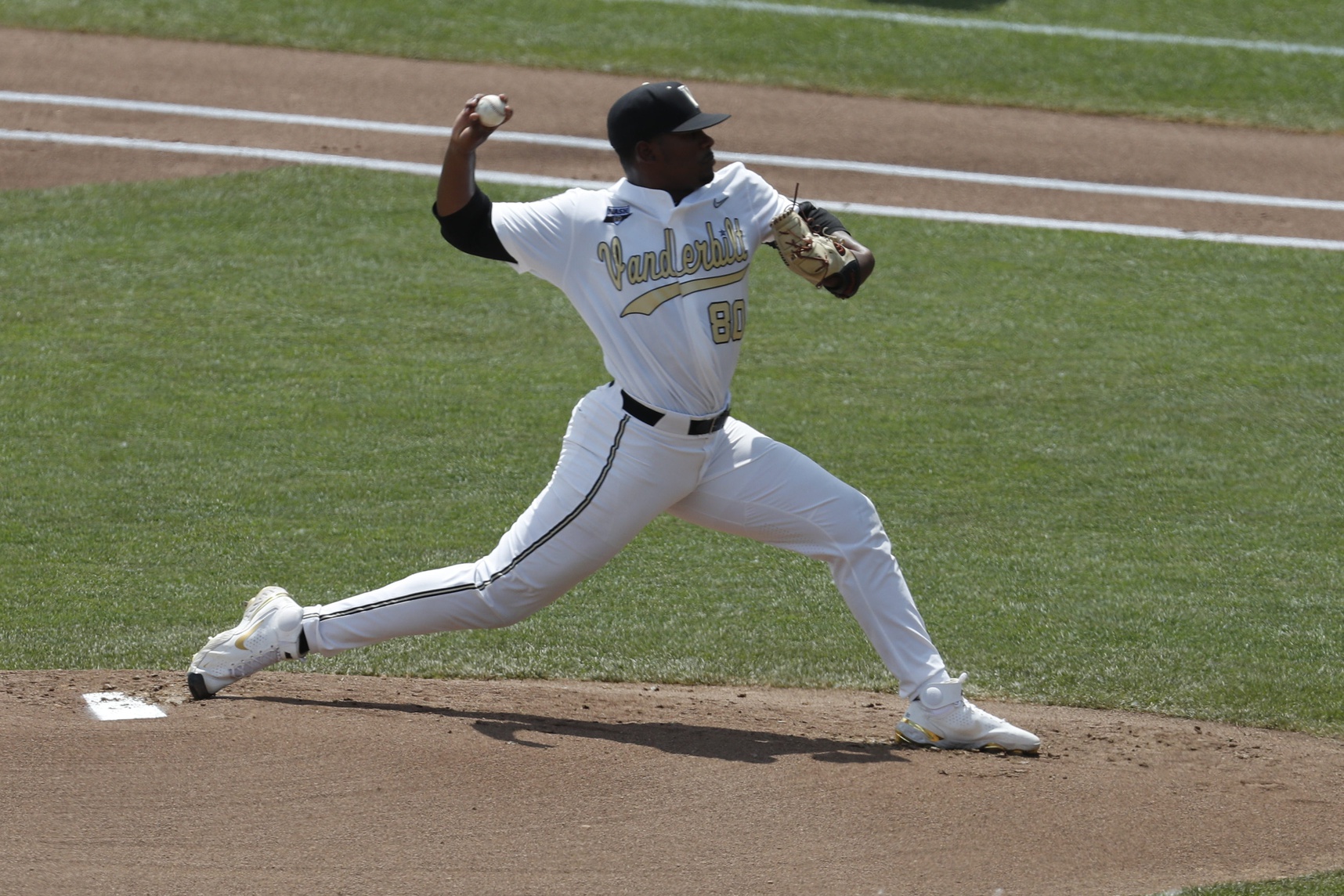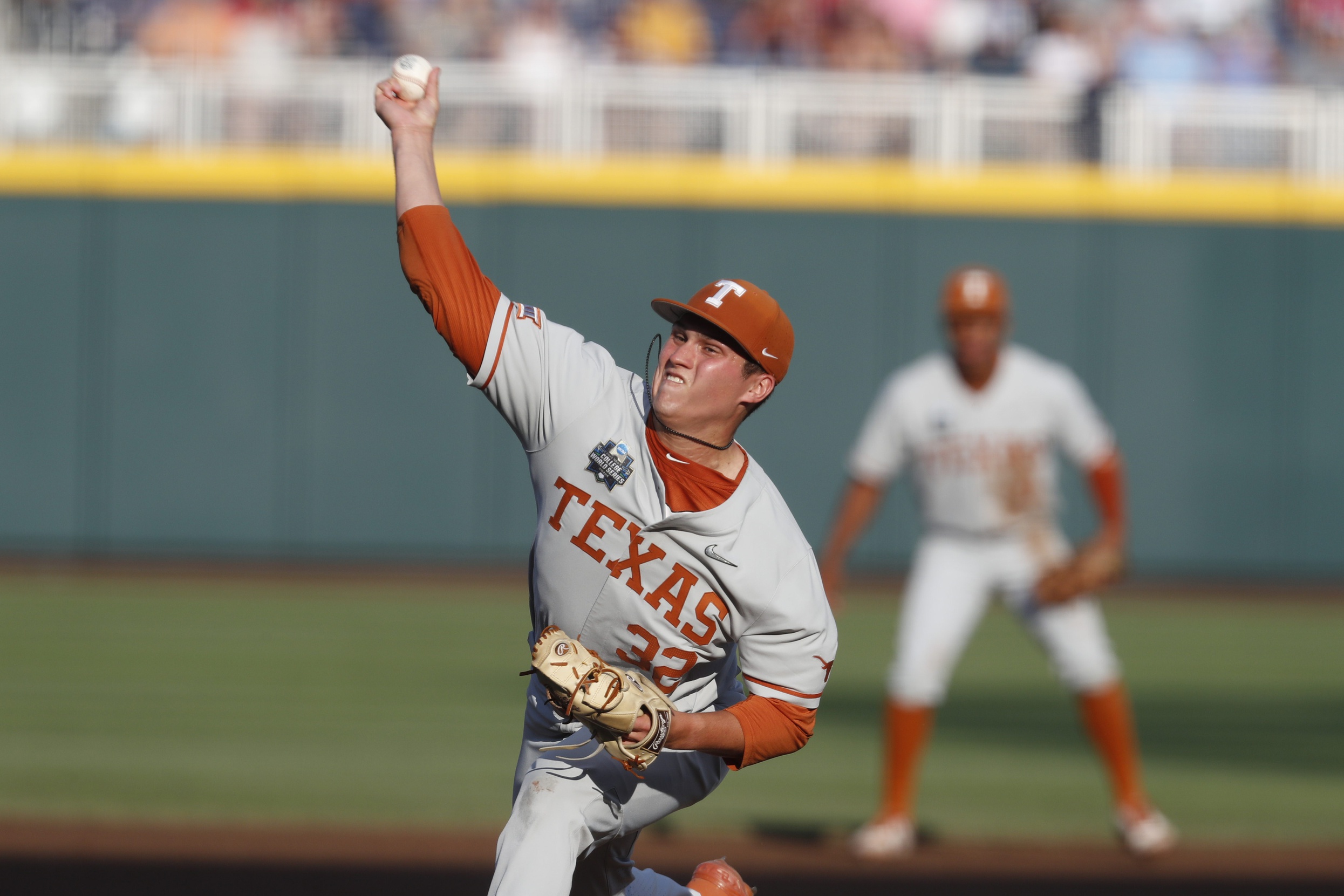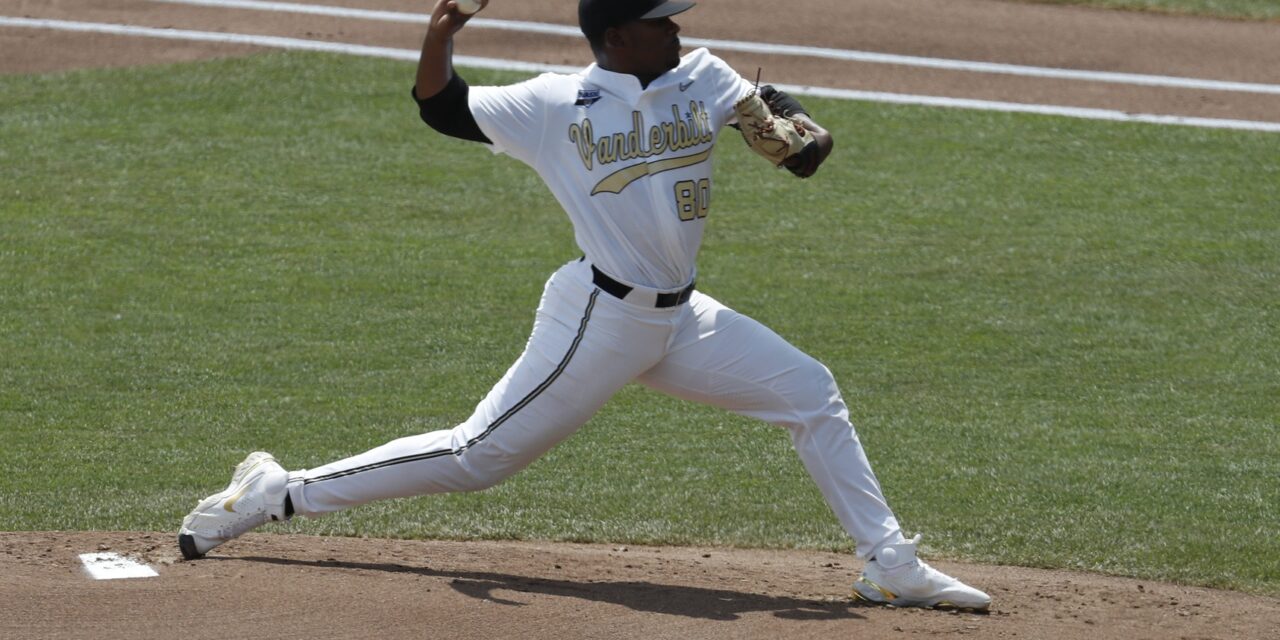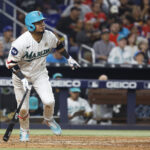
Jun 25, 2021; Omaha, Nebraska, USA; Vanderbilt Commodores pitcher Kumar Rocker (80) throws against the NC State Wolfpack at TD Ameritrade Park. Mandatory Credit: Bruce Thorson-USA TODAY Sports
The major league draft is set to kick off on July 11th, and the Mets are sitting at No. 10 in the first round draft order. The Mets are expected to take the best player available, but who that player is depends on how the nine picks before them shake out.
*Note, players are listed in no particular order.
Sal Frelick, OF, Boston College
Frelick is arguably the best college bat available in this year’s draft. Frelick was mocked to the Mets as recently as last week by MLB.com’s Jim Callis. To date, Frelick is hitting .359/.443/.559 with 13 stolen bases through 48 games for Boston College. He’s a little undersized, coming in at 5’9″, 175 pounds from the left handed batter’s box. Frelick fits an organizational need for the Mets with their lack of legitimate outfield prospects, and could move through the system quickly.
Frelick, 21, came out of the 2018 class as Perfect Game’s second best shortstop in the state of Massachusetts. Frelick has played some infield in summer ball in the last few years, but has exclusively been an outfielder in ACC play. Frelick brought home a Gold Glove Award for his 2021 work, which was the first in school history. He appeared in center field in all 48 games he played this season. His smaller frame raises questions, but his glove and bat to ball skills show more than enough reason to believe that Frelick can contribute at the major league level and soon.
Sam Bachman, RHP, Miami (OH)
Bachman, probably the most unknown of the names on this list, comes from Miami University (Ohio). Bachman, the thrower of what he calls a “gyro-slider,” has shot up draft boards recently. In the MAC, Bachman dominated. The 6’1″ righty pitched to a 1.81 ERA over 12 starts. He allowed just one homer, and almost cut his WHIP in half from 2020 to 2021, going from 1.31 to 0.77. Bachman’s control has taken massive strides, with his BB/9 shrinking from 4.6 his freshman year to 2.6 this past season.
According to ProspectsLive, Bachman throws a fastball, a curveball, and a slider. He sits in the mid-90s with his fastball, mid-80s with his changeup, and ranges anywhere from 83 to 87 with his slider. The righty has a quick and compact motion, tailing off to the first base side with his follow-through. Bachman was mocked to the Mets recently by The Athletic’s Keith Law. Law noted that Bachman had shoulder injuries early in the spring, but based on talent alone could go in the top 10. Law stated that Bachman could “easily slip out of the first round if teams are scared by his medicals.”
Colton Cowser, OF, Sam Houston
Colton Cowser, much like Bachman, comes from a relatively unknown school in Sam Houston State University. Cowser, 21, was an absolute menace in the relatively unknown Southland Conference. He hit .374/.490/.680 to go along with 16 bombs and 17 stolen bases in 55 games. He exclusively played center field over the last two seasons, but his 6’3″, 195-pound frame allows for him to play any outfield spot given an ability to learn it. Cowser came in as McDaniels’ 10th-ranked prospect in the draft, and was recently mocked to the Phillies at No. 13.
As was mentioned before, rarely does a team draft based on need, let alone major league need. However, Cowser is one of the most advanced bats in this class, and fills an organizational need for the Mets with upper level minor league outfield prospects. MLB Pipeline said of Cowser that “Scouts were somewhat split on Cowser’s ability to play center field, though they believe in him now that he has posted consistent plus running times this spring. He has good defensive instincts in center, possesses an average arm and spent most of his prep career in right field.” Cowser fits a deep need for the Mets, and could slot perfectly into a system that is in desperate need for outfield prospects.
Kumar Rocker, RHP, Vanderbilt
Here, we see the only of the two “Vandy boys” that the Mets have a chance at. Rocker has been mocked from everywhere from the top three, to slipping to the back end of the top 10. Rocker has not been explicitly mocked to the Mets, it is rumored that 11 (the Nationals) is his floor in this year’s draft. In his recent mock, Law noted that the Mets would be willing to go over slot for Rocker at 10 to secure his signing, but it is far from a guarantee that the righty even gets to 10.
Rocker burst onto the scene as a freshman in 2019 with a no-hitter against Duke in early June. He pitched to a 3.25 record with a 10.3 K/9 over the course of his freshman year. He only threw 15 innings in a shortened 2020 season, and then took a bit of a back seat to the draft’s top pitching prospect Jack Leiter as they continue their hunt for a national title.
Rocker is 13-3 with a 2.98 for the nation’s top baseball program. He sits mid-to-high 90s with his fastball, but is inconsistent with his velocity. He has reached as high as 99, but as gone as low as 92. He also employs a curveball, a changeup, and a slider, the later of the three considered to be his best pitch. he profiles as a future front-line starter at his peak, and a back-end starter at his absolute worst.

Jun 25, 2021; Omaha, Nebraska, USA; Texas Longhorns pitcher Ty Madden (32) throws a pitch against the Mississippi State Bulldogs at TD Ameritrade Park. Mandatory Credit: Bruce Thorson-USA TODAY Sports
Ty Madden, RHP, Texas
After the two Vandy boys, Madden likely profiles as the best college arm in the draft. At 6’3″, 215 pounds, Madden is an imposing righty that sits between 92-96 with his fastball. Madden is a three pitch pitcher at this stage in his career, featuring a fastball, a changeup, and a slider. Madden is pitching to a 7-5 record with a 2.93 ERA and a K/9 of 10.8 over 107.2 innings.
Madden has seen his walk numbers begin to rise again, after getting them down in a shortened 2020 season. He began his Big 12 career with a 5.1 BB/9, he was able to drop it to 1.4 in 25 innings in 2020. to 3.4 in 107.2 innings his junior year. His numbers rose back up in 2021, however, with his BB/9 sitting at 3.4. Still an improvement from his initial rookie numbers, however.
The Texas Longhorns’ ace mainly sits with his fastball and slider, but can use his changeup from time to time. Fangraphs‘ Kevin Goldstein wrote about Madden’s changeup, saying that it is “Rarely used, but not a disaster. A little firm at 85-87 and features more drop than fade. Telegraphs the pitch a bit with a much calmer finish to delivery. There’s an idea here, but will need to be a point of development as a pro.”
Madden throws over the top, with a move that ends him on the first base side of the rubber with an open leg swing. Madden, like Frelick, would likely move through the minor leagues quickly and reach the Major Leagues relatively soon.
Jackson Jobe, RHP, Heritage Hall HS (OK)
Jobe, 18, is the consensus top high school pitching prospect in this year’s class. Jobe is committed to Mississippi as of right now, but a top-10 selection could easily change his mind. Jobe comes in at 6’2′, 190 pounds. According to Perfect Game, Jobe’s fastball tops out at 96 MPH. Jobe is listed as a RHP/SS/3B, but will most certainly be drafted as a pitcher and with the intent of the drafting team to develop him as a pitcher only.
Goldstein, when talking about Jobe in a FanGraphs mock draft, said that “Jobe arguably has the best single pitch in the draft with a slider that has earned some 80 grades, but comes with all of the usual risks attached to high school arms.” Jobe’s motion is one that is very over the top, making for easy velocity and vertical movement. The Mets have gone the way of high school arms a decent amount in recent years, but have not done so. They’ve selected Simeon Woods Richardson (48th), and Matthew Allan (89th) in the first three rounds of the last two “normal” drafts, but those are the highest high school arms they’ve selected of late.
Matt McLain, INF, UCLA
McLain is the name that has been most connected to the Mets since the beginning of the process. McLain, who turns 22 in August, is probably one of, if not the most advanced bat in this year’s draft. McLain was taken by Arizona out of high school in the first round of the 2018 draft, but elected to go play college ball instead. McLain hit .333/.434/.579 with nine bombs and 36 RBI over 47 games. The 5’11, 180 pound righty has exclusively played shortstop over the last two seasons, but it isn’t clear yet whether or not he profiles as a long-term shortstop.
In his first mock draft on May 11th, Kiley McDaniel of ESPN mocked McLain to the Mets. In the aforementioned mock from FanGraphs, both Goldstein and Eric Longenhagen agreed on the Mets being a landing spot for McLain. Goldstein stated that “The Mets have been attached to McLain for some time now” and Longenhagen added that “The Mets had the most heat in to see McLain during his final regular season weekend at ASU.”
Gunnar Hoglund, RHP, Mississippi
Hoglund, much like Madden, slots into the tier under the Vandy boys for this year’s class of college arms. Hoglund was selected with the 36th overall selection in the 2018 draft by the Pirates, but Hoglund stuck to his SEC commitment. Hoglund is an imposing presence on the mound, standing at 6’4″ and weighing 220 pounds. In 11 starts this season, Hoglund pitched to a 2.87 ERA, a WHIP of 0.91, and a K/9 of 13.8. Hoglund went to Miami in McDaniels’ Mock 2.0.
Hoglund, according to MLB Pipeline, sits 92-95 with his fastball to go along with three secondary pitches that they list as a slider, a changeup, and a curveball. Pipeline rates all of his pitches as 55 grades except for his curveball, which sits at a 50 grade. Hoglund has demonstrated excellent control over his collegiate career, posting a 2.0 BB/9 over his three seasons at Ole Miss. He averaged just over five innings per start in his junior year, but overall impressions seem to not worry over whether or not that is indicative of his future as a starter. It should be noted that Hoglund will need Tommy John surgery, which some scouts say could slip him to the later half of the first round.
Colson Montgomery, INF, Southridge HS (IN)
Montgomery fits the Mets recent first round strategy to an absolute T: an early prep bat. The Mets have gone with a high school bat each of the past three drafts and have seemingly hit on them all to date: see Jarred Kelenic, Brett Baty, and Pete Crow-Armstrong. Montgomery, who stands in at a whopping 6’4″ with a skinny frame at 190 pounds, provides potential to be an absolute tank at the plate. Montgomery, an Indiana commit, hits for pop out of the left-handed box. He currently lists as a shortstop, but his build likely sees him move off the spot relatively soon.
Montgomery ranked as Kiley McDaniels‘ 17th ranked prospect in the draft, but as was mentioned before, is an organizational fit for the Mets based on draft philosophy. Although you don’t necessarily draft based on positional need, Montgomery would join an already stacked group of young infielders for the Mets that includes Baty, Ronny Mauricio, and Francisco Alvarez. Montgomery’s commitment to Indiana could become an interesting caveat in any contract negotiations, but it isn’t known to be a deal breaker or any different from negotiations the Mets underwent with Crow-Armstrong and Baty.
















